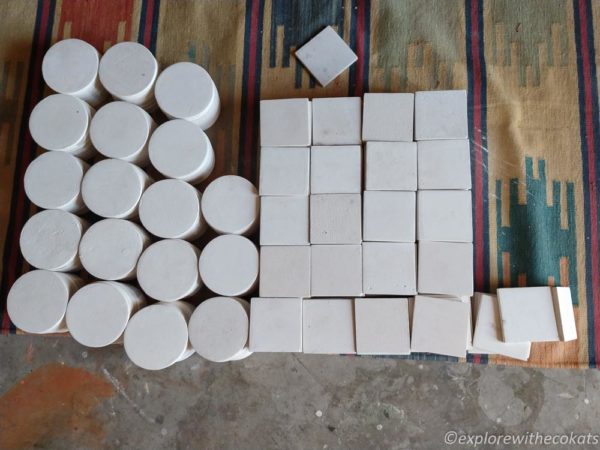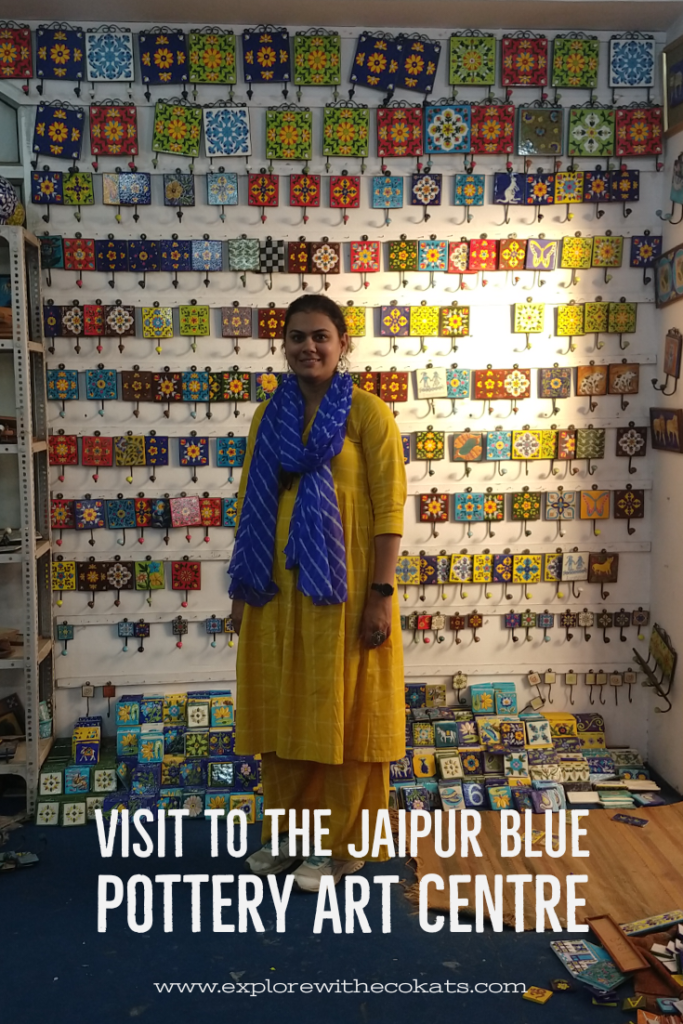Last Updated on July 26, 2022 by
The Pink city of Jaipur offers fascinating arts and crafts to visitors. One of them being the Blue Pottery of Jaipur. This guide covers the process of making Jaipur Blue Pottery and where to purchase them in Jaipur.
Out of all the places to visit in Jaipur, exploring the Blue Pottery of Jaipur was my highlight.
I visited the Blue Pottery Art Centre in Jaipur city and thoroughly enjoyed the knowledge about the craft.
Table of Contents
Jaipur Blue Pottery Art Centre
The exterior of Jaipur Blue Pottery Art Centre is inviting with its royal blue and turquoise colour palette. One can only imagine what the inside would contain. But be prepared to be blown away because the entire store (which is a huge two-storeyed space) is full of pottery pieces.

As I walked in my eyes were getting wider trying to process the sea of Jaipur Blue Pottery and a child-like excitement in a candy store.
A salesperson stopped me and asked if I would be interested to know about the process before I went into the store. And I was more than happy to know it. Before he could start explaining I mentioned that I was a travel blogger and would document the process on my blog with permission.
He asked me to wait and called upon the owner – Mr. Anil Doraya. Mr. Doraya is the 7th generation of his family to make Jaipur Blue Pottery. Mr. Doraya was more than happy to know that I would feature his craft on my blog and personally requested to assist me.
I was then explained the entire history and process of making Jaipur Blue Pottery which has received the Geographical Indications (GI) status.

Blue Pottery of Jaipur – the History
Inspired by Persian art, Jaipur Blue Pottery is believed to have originated in Middle East Asia and came to India in the 17th century. Before its arrival in India, the Blue Pottery was used only for decorating mosques and tombs across Central Asia. The art combined Chinese glazing technology and started being used on everyday utility items.
According to the legend, Maharaja Sawai Ram II attended a kite flying session and watched two brothers from Achnera bring cut the royal kites which were flown by his kite masters. The brothers had coated their strings with glass-like dust from their pottery practice. The Maharaja was intrigued and impressed with this technique and invited the brothers to stay in Jaipur and teach this unique form of glazed pottery at his art school.
The name ‘Blue Pottery’ comes from the vibrantly attractive royal blue dye that is used to colour the pottery. The pottery is hand-painted with designs inspired by nature which makes each item unique, beautiful, and personalized.

Making of Jaipur Blue Pottery
Jaipur Blue Pottery does not use clay-like most pottery forms but uses a special dough. It is a long and tedious process involving many steps and is time-consuming. I was shown the entire process in a small workshop on the shop premises. This process largely takes place in the larger workshop in Sanganer, which can also be visited with prior permission.
Making the Dough
The dough is prepared by using these ingredients: quartz stone powder, powdered glass, Multani Mitti (Fuller’s Earth), borax, gum and water. The ratios are 1 part each of gum, salt, and clay. The raw materials are mixed with water and left overnight. The next day they are kneaded together into a uniform consistency and again left for 2–3 days before use.
Formation
The dough is then rolled and flattened to form a circle of 4-5 millimetres. This is then shaped into the desired plaster moulds with a mixture of stones and ash made from burnt wood by gently hand pressing them inside the mould. The mould is now turned upside down and removed, and the dough obtained is left to dry. The excess ash is brushed off the item and cleaned. If uneven thickness occurs during the drying process, the dried dough is simply rehydrated until it is leather hard and trimmed to uniformed thickness using a sharp knife.

Decoration and Glazing
The item is further rubbed to give it polish and the perfect finish with ‘Regmaal’ (glass paper). The item is then dipped in a solution of quartz powder, powdered glass, edible flour (maida), and water and dried.
A design is made on the dried, coated vessel with a pencil at first and then in order to create the underglaze colours, it is coloured using a solution of cobalt oxide and edible gum, and the colouring is done by using oxides of various metals.
The colours of Jaipur Blue pottery are as follows: copper to create turquoise; chromium to create green; cobalt to create dark blue and black; iron to create brown; cadmium to create yellow, and manganese to create purple.
The designs range from geometric designs, floral designs, and animals and birds such as elephants and peacocks. Some designs also have images of Indian gods and goddesses.
The item then undergoes another round of sanding, the piece is finally ready for the underglaze.
After the decoration is finished, the work is glazed. Making the glaze is a very involved process. A combination of powdered glass, borax, zinc oxide, potassium nitrate, and boric acid is mixed together and heated until the mixture melts. After it cools, the resulting glass is again ground into a fine-powdered frit and mixed with maida and water to create the final glaze. After being dipped in the glaze, all pieces are set in the sun to dry.
Firing
Jaipur Blue Pottery uses a wood-fired kiln with a small pit in the front. The wood is lighted here and maintained for 8 hours at 1000 degrees celsius. The kiln is specially designed for blue pottery and requires skills for operation.
After firing them for 8 hours, they are cooled for 2–3 days. The kiln is unloaded and the pieces are sorted and sent off to market.
Compared to other pottery items, Jaipur Blue pottery is much more fragile. Maybe that is a price worth paying for stunning designs.

Shopping for Blue Pottery of Jaipur
Apart from a few shops in Jaipur, Jaipur Blue Pottery Art Centre is one of the most authentic places to buy Blue Pottery. It is one of the many souvenirs to buy from Jaipur. This two-storeyed store is sure to woo the visitors with its thousands of products on display.
The options are countless. From bathroom accessories to kitchen essentials, from wall decorations to jewellery, from storage cabinets to tiles, one can find all sorts of options in the store. They also make personalized designs if ordering in bulk.
The price range starts from INR 200 to INR 50,000 for most intrinsic pieces which sometimes take over a month to prepare.
Workshops for Jaipur Blue Pottery
If students or artisans want to learn the art of making Blue Pottery, they can enrol themselves for workshops which span from 2 weeks to 2 months where one learns everything about the art. Workshops are conducted on the third floor of this store.
Jaipur Blue Pottery Art Centre
Near Jain Mandir,
Amer Road, Jaipur 302002
Contact: Durgesh Doraya – 9636079607
Email: [email protected]
Have you been to Jaipur before and visited or bought Blue Pottery? Have you seen Blue Pottery in any other part of the world? Tell me in the comments below.
Read more articles on Rajasthan here
Instagram worthy places to visit in Jaipur
Disclosure: A short article of this version was printed in Hashtag Magazine.
Disclaimer – This post contains affiliate links. It means it adds no extra cost to you if you book through the link but I get a referral bonus which helps me earn a little to keep this website up and running.
Pin this post!




6 comments
Did you try your hand at pottery too? I did, in Vietnam, It was such a lovely experience.
Hey Anukrati.. I have tried the traditional pottery wheel but Jaipur blue pottery is a whole different ball game so not possible to try that.
These are beautiful! I love finding authentic hand made gifts when travelling! You can feel the love that goes into making them.
Interesting post as always! The photo of yourself wearing blue and yellow is beautiful!
So gorgeous! When travelling through Latin America, I was very impressed by the pottery and especially blue tiles in Mexico and Panama. I took so many pictures. Now I know Jaipur’s scene can definitely rival theirs!
What a very complex process it it. The pottery is absolutely beautiful!